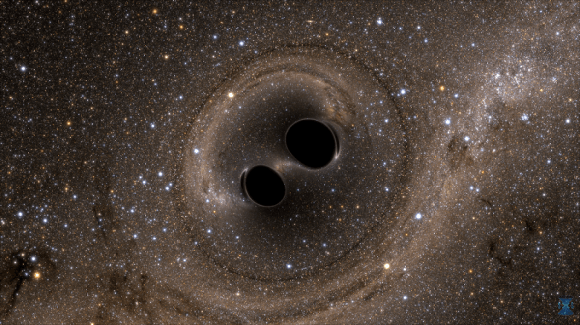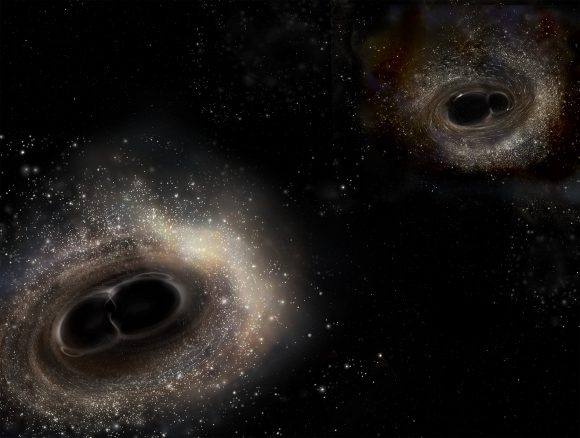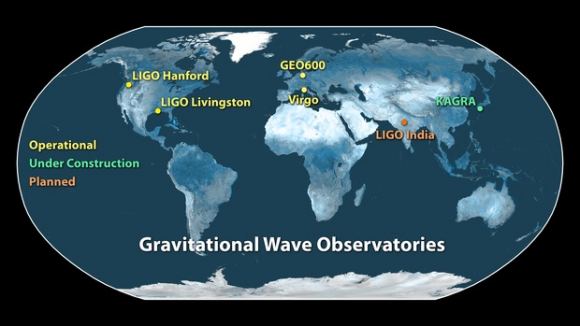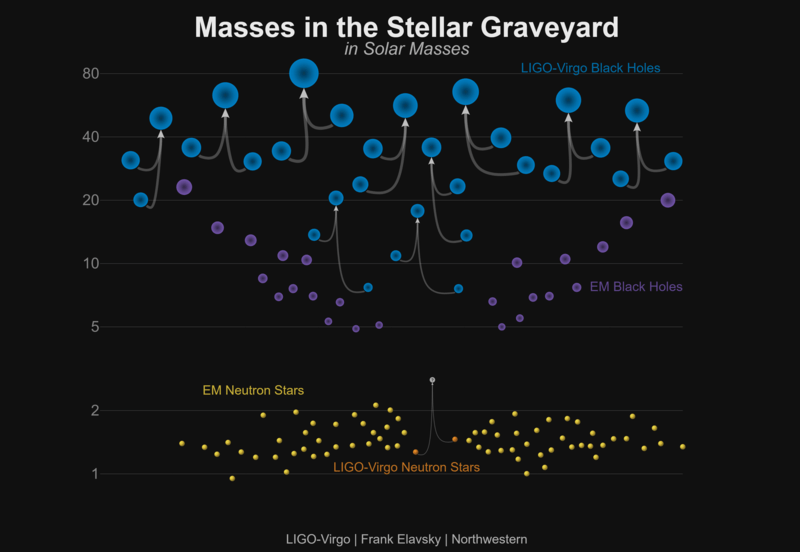On February 11th, 2016, scientists at the Laser Interferometer Gravitational-wave Observatory (LIGO) made history when they announced the first-ever detection of gravitational waves (GWs). Since that time, multiple detections have taken place and scientific collaborations between observatories – like Advanced LIGO and Advanced Virgo – are allowing for unprecedented levels of sensitivity and data sharing.
Previously, seven such events had been confirmed, six of which were caused by the mergers of binary black holes (BBH) and one by the merger of a binary neutron star. But on Saturday, Dec. 1st, a team of scientists the LIGO Scientific Collaboration (LSC) and Virgo Collaboration presented new results that indicated the discovery of four more gravitational wave events. This brings the total number of GW events detected in the last three years to eleven.
The presentation, titled “Binary Black Hole Population Properties Inferred from the First and Second Observing Runs of Advanced LIGO and Advanced Virgo“, was made during the 2018 Gravitational Wave Physics and Astronomy Workshop (GWPAW) – which took place from Dec. 1st to Dec. 4th at the University of Maryland.

Hosted by the Joint Space-Science Institute (JSI), a partnership between the University of Maryland and NASA’s Goddard Space Flight Center, this annual event brings scientists and researchers from all around the world together to discuss current and future issues related to the detection and study of gravitational waves.
In the course of the presentation, Michael Pürrer – a senior scientist in the Astrophysical and Cosmological Relativity division at AEI Potsdam – presented the results of the first catalog at GWPAW on Saturday on behalf of the LIGO Scientific Collaboration and Virgo Collaboration. These included the seven previously detected events and the four recent detections. As he stated during the presentation:
“In this catalog we present a thorough analysis of all 11 gravitational-wave detections found in O1 and O2. We rely on state-of-the art models of the gravitational waveform emitted from these cataclysmic events to infer the binaries’ masses, spins and tidal deformabilities. I am very proud to have been part of this outstanding effort by the LIGO Scientific Collaboration and Virgo Collaboration.”
The new events, which were all the result of BBH mergers, are designated GW170729, GW170809, GW170818 and GW170823 based on the dates on which they were detected. All four were detected during the LIGO and VIRGO collaborations second observing run (O2), which lasted from November 30th, 2016 to August 25th, 2017.

Alessandra Buonanno, the director of the Astrophysical and Cosmological Relativity division at AEI-Potsdam and the College Park professor at University of Maryland, was a major contributor to these recent finds. As she indicated in a recent AEI press release:
“State-of-the-art waveform models, advanced data processing and better calibration of the instruments, have allowed us to infer astrophysical parameters of previously announced events more accurately. I look forward to the next observing run in Spring 2019, where we expect to detect more than two black-hole mergers per month of collected data!”
According to the team’s results, the observed BBHs span a wide range of component masses, from 7.6 to 50.6 solar masses. They team also found that in two of the BBHs (GW151226 and GW170729), it is very likely that at least one of the black holes is spinning. But most important of all, the new detections set two new records in the study of GWs.
For instance, the event known as GW170818 was located in the sky with pinpoint accuracy in the northern celestial hemisphere by the LIGO and Virgo observatories. In fact, it was identified with a precision of 39 square degrees (195 times the apparent size of the full moon), making it the best localized BBH to date.

In addition, the event known as GW170729 was the most massive and distant gravitational-wave source observed to date. In addition to involving a black hole pair that had a combined mass more than 50 times that of the Sun, the merger took place 5 billion years ago and released the equivalent of almost five solar masses in the form of gravitational radiation.
Looking ahead, the team hopes to make more discoveries during the third observing run (O3) of Advanced LIGO and Virgo, which is planned to start in early 2019. This run will benefit from further sensitivity upgrades to LIGO and Virgo, as well as the inclusion of Kamioka Gravitational Wave Detector (KAGRA) observatory in Japan (possibly towards the end of O3).
As Karsten Danzmann, the director of the Laser Interferometry and Gravitational Wave Astronomy division at AEI-Hannover, expressed:
“I am happy that many of the advanced detector technologies developed at our GEO600 detector have helped to make the O2 run so sensitive and that in O3 another technology pioneered at GEO600, squeezed light, will be employed in LIGO and Virgo.”

With these upgrades and the addition of KAGRA, many tens of GW events resulting from the merger of binary systems are anticipated in the coming years. These latest results also offer further validation of the LIGO and Virgo observatories instruments, as well as the effectiveness of the international collaboration behind them.
And with the detection of four additional GW events, the number of case studies scientists can draw insights from has grown by almost 50%. In so doing, they will be able to learn more about the population of binary systems that cause GW events, not to mention the rate at which these types of mergers take place.
The results of the team’s searches were also presented in two papers that recently appeared online. The first paper, “GWTC-1: A Gravitational-Wave Transient Catalog of Compact Binary Mergers Observed by LIGO and Virgo during the First and Second Observing Runs, presents a detailed catalog of all the gravitational wave detections.
The second paper, “Binary Black Hole Population Properties Inferred from the First and Second Observing Runs of Advanced LIGO and Advanced Virgo”, describes the characteristics of the merging black hole population. LIGO is funded by the National Science Foundation (NSF) and operated by Caltech and the Massachusetts Institute of Technology (MIT).
Further Reading: Albert Einstein Institute

